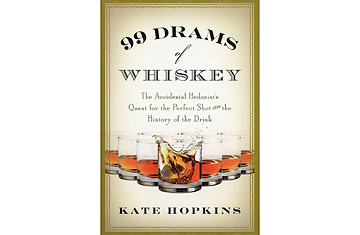
People will do crazy things for the devil's brew. Take the guy who, in 2005, spent more than $70,000 on a single bottle of Dalmore 62 Single Highland Malt Scotch Whisky — one of 12 bottles in the world — and then proceeded to consume it, in one sitting, with a few friends and an English bartender. It was this very story that inspired food blogger Kate Hopkins to trek across the globe, from a 200-year-old distillery in Scotland to Maker's Mark House and Lounge in Kentucky, for her first book, 99 Drams of Whiskey. TIME spoke with Hopkins about different brands' personality types (for the record, Bushmills White Label is "the Julia Roberts of the whiskey world"), why drinking water with whiskey is key and whether "Mr. Disposable Income" got his money's worth for that $70,000. (See pictures of whiskey-making.)
You initially balked at the idea of learning how to properly taste and describe whiskey. How did you go from that to describing brands like High Wine Whiskey as "the rebel no one wants you to date."
There's a certain amount of hesitation some people have to trying to understand what they're consuming, whether it's ice cream or whiskey. By personalizing it in a way that is atypical of how most reviewers describe whiskey, I think it's more approachable. So when I say Maker's Mark is like the genius who decided to become an auto mechanic for the rest of his life, I think people understand what that means, rather than saying, "It has hints of vanilla with undertones of molasses."
You visited a distillery in Kentucky called Buffalo Trace, which takes a rather unique style to making whiskey.
Buffalo Trace has what they call an "experimental" line, and what they do is they try a little bit of everything to see what kind of taste variations they can get. They do all sorts of things there, they use rice in their mash, they use different ages, different kinds of barrels. The one I had was aged in a cabernet cask. There are a great many people who love whiskey who take themselves very seriously. And the ironic part of that is that a lot of the people who sell whiskey, they're very carefree. They just want to enjoy themselves.
Why are there so few distilleries trying to reinvent the drink?
From my own personal observation, it's that the larger companies, the Pernod-Ricards of the world, are slow to react because they have a safe base. They make a lot of money, so why challenge that? The other aspect is that whiskey, as a whole, is seen as a very traditional drink. So if you do something innovative you're going against the grain, if you pardon the pun. (See reviews of 50 American wines.)
Your book also notes how whiskey labels are like historic artifacts. Canadian Club's history, for example, is closely tied with the Prohibition and Al Capone.
One of the things that Canadian Club is realizing now is the fact that as they get further away from the Prohibition era, and those ties to gangsters, they can use that now as a marketing tool. Part of that is this rebellious nature of whiskey — there are more tall tales of whiskey than you'll see in wine or beer combined, I'm willing to bet. They want to make it larger than life.
What surprised you most about whiskey's history?
The amount of history we've lost after Prohibition and World War II. A lot of the companies were bought or moved, many of them went out of business and they didn't think to maintain the heritage of these distilleries. Whiskey was a vital component of the pioneer era; it was used as currency because you couldn't get coins to certain parts of the territories, so they had to find the most valuable product that everyone could obtain, and whiskey filled that void very nicely. If you made whiskey, you could keep your family fed.
Which brings me to my next question, about the man who inspired you to write this book. You refer to his as "Mr. Disposable Income." After researching this book, did your perception of him change?
I couldn't fathom why someone would pay that much money for a single bottle. It was akin to buying a rare Picasso, and then taking out of its frame and putting it on your college dorm wall. What I found out later is the gentleman was celebrating, he had just made a lot of money on stocks. And I thought that was great because, clearly, it's a god-awful amount of money to spend.
So what does your liquor cabinet look like?
I can tell you right now I have 63 varieties of whiskey. Those were acquired over the course of "research." I had a little over 100 drinks on the trip. A lot of spitting out, unfortunately.
What's the proper way to drink whiskey?
One, you have to have some measure of water, whether it's just a capful or a one-to-one ratio. It lessens the alcohol and brings out the flavors. Every whiskey professional that I've been in contact with added some measure of water. People who just drink it straight are showing off that they can drink alcohol straight. And remember: getting drunk dulls the senses, so if you want to taste whiskey, getting drunk is not the way to do it. It's certainly a nice side effect, though.
